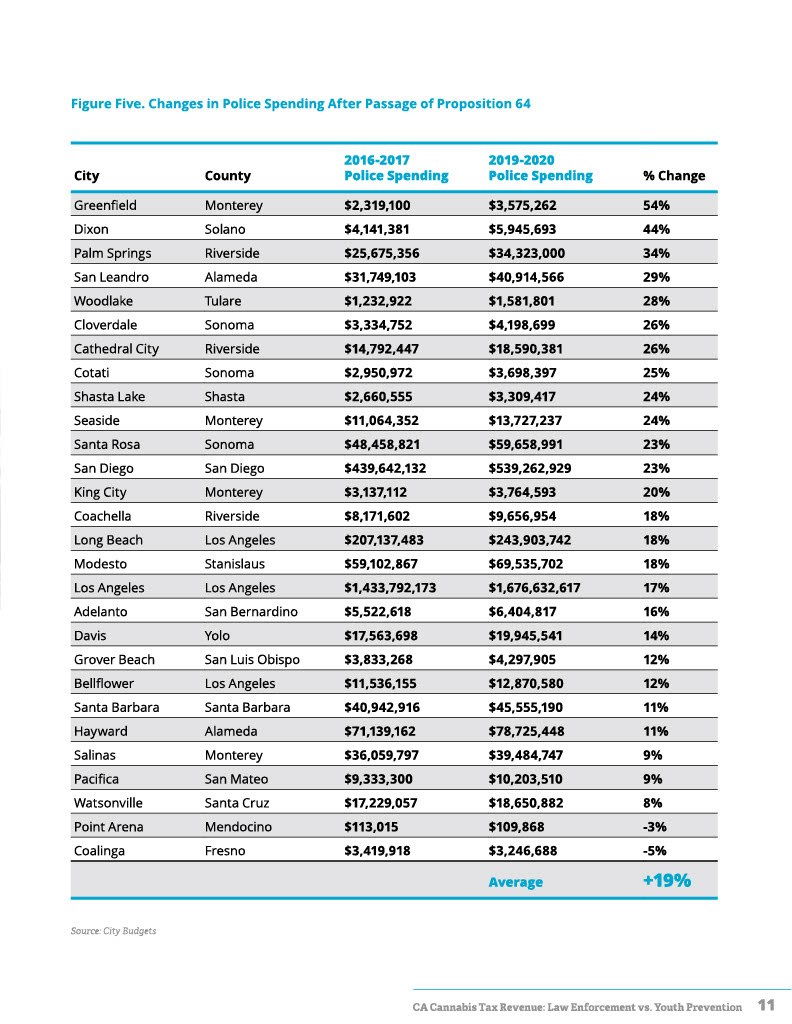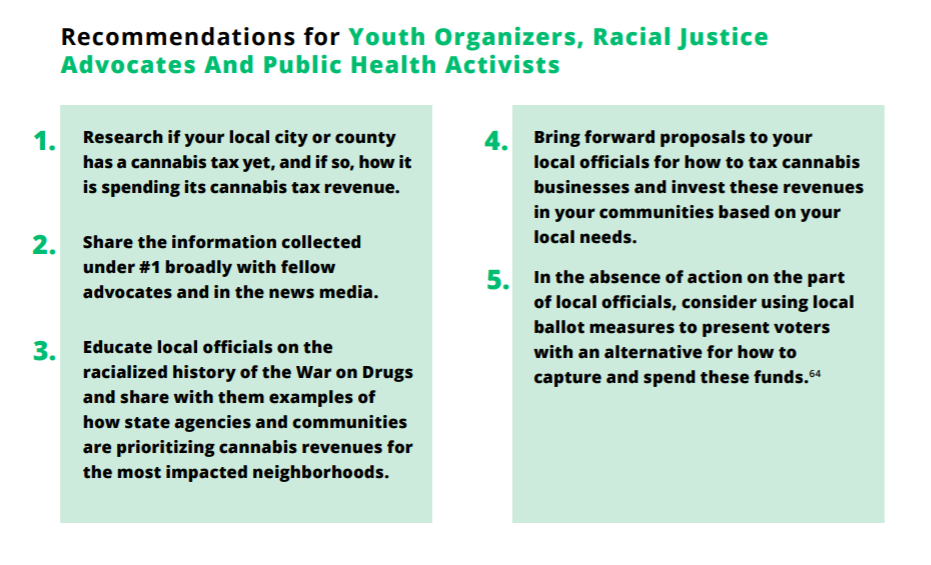
California Cannabis Tax Revenues: A Windfall for Law Enforcement or an Opportunity for Healing Communities?
- Lynn Silver, MD, MPH, FAAP
- Jim Keddy, Alisa Padon

In 2016, California passed Proposition 64 and legalized recreational cannabis. Voters believed that legalizing marijuana would right some of the wrongs of the War on Drugs—especially the mass criminalization and incarceration of young, mostly black and brown men. Prop 64 also promised to generate new revenues that would be invested in youth programs, substance abuse prevention and treatment, environmental restoration and public health initiatives.
But, says a new report, cities across the state are funneling new cannabis revenues into law enforcement.
To better understand the impact of the taxes imposed by localities, authors researched 28 California cities that were the first to pass recreational cannabis ordinances related to Proposition 64 and that had actually begun to collect cannabis-related revenue by 2018. Those cities were estimated to bring in over $85 million from local cannabis taxes in just the 2019-20 year.
The revenue collected from cannabis in nearly all these cities goes into their “general fund” where it is used to pay for various city services—including the youth and prevention services called out in Prop 64.
However, for most cities, the largest chunk of their general fund spending goes toward the police. On average, for the 28 cities in the study, police spending represented 39% of general fund spending. Without any affirmative efforts to direct additional resources elsewhere, new revenues such as those from cannabis that go into the general fund end up heavily benefiting the police.
Additionally, instead of actively seeking to direct new revenues elsewhere, many jurisdictions are instead explicitly seeking to use cannabis revenues to expand police budgets. For example, San Diego has decided that “enforcement of marijuana laws” and “proactively cracking down on illegal operators” should be prioritized in deploying cannabis revenues. Los Angeles is directing millions of dollars per year in cannabis revenues to the police “overtime fund” where it is used for “investigating and enforcing laws relative to illegal cannabis businesses” among other law enforcement functions. And the small city of Woodlake, which only has a city police budget of $1.6 million and nine police officers overall, uses its cannabis revenue to “fund an additional officer, an additional K9, and a patrol vehicle.”
Report findings
The report found that, between 2016-17 and 2019-20:
- 23 of the 28 cities that had passed recreational cannabis ordinances related to Proposition 64 and begun to collect cannabis-related revenue by 2018 experienced double-digit increases in the amount of general fund dollars going into their police budgets.
- Eight of the 28 increased their police budgets by at least 25%.
- The average shift in police budgets for these 28 cities was an increase of 19%.
- Ultimately, in just those cities, over $455 million more in general fund dollars was spent on police in 2019-20 than was spent just three years earlier.
Plus, while the enforcement of cannabis laws has always been concentrated within communities of color, it has become even more so in recent years. People of color represented 68% of cannabis arrests in 2013, but by 2018 that had risen to 75% (though with far fewer cannabis arrests in total).
As a result of this continued infusion of resources into law enforcement strategies, California’s War on Drugs has raged on. California’s criminal justice system is still being flooded with drug arrests (though most are now misdemeanors). In fact, there were more people arrested for drug offenses in California in 2018 than there were before these initiatives were introduced.
The report includes positive examples from cities and counties that have used their new cannabis revenues to invest in youth, early childhood education and intervention programs, addressing homelessness and more:
- Santa Ana is dedicating $3.1 million in cannabis revenues this year to youth services, including tutoring services, internships, and youth enrichment programs.
- Santa Cruz County is investing $350,000 in cannabis revenue per year in the Thrive by Three program, which is dedicated to creating a robust system of care for children from low-income families and their families. It includes initiatives such as the Nurse-Family Partnership, a research-based community health program in which specially-trained nurses regularly visit first-time mothers from early in their pregnancies until their child’s second birthday.
- Monterey County is allocating nearly a million dollars in cannabis revenues in 2019- 20 to initiatives including early childhood education and intervention programs, a homeless shelter, and the Whole Person Care program, which provides comprehensive case management services to those who are homeless, have mental illness or substance use disorders, or have multiple chronic diseases.
Report recommendations
The report includes recommendations for local officials, state government, and activists, including:

California Cannabis Tax Revenues: A Windfall for Law Enforcement or an Opportunity for Healing Communities? is co-authored by Youth Forward and PHI’s Getting It Right from the Start, and co-sponsored by the Alliance for Boys and Men of Color, California Pan-Ethnic Health Network, California Urban Partnership, Children’s Defense Fund CA, Prevention Institute and Public Health Advocates.
Originally published by Public Health Advocates
Work With Us
You change the world. We do the rest. Explore fiscal sponsorship at PHI.
Support Us
Together, we can accelerate our response to public health’s most critical issues.
Find Employment
Begin your career at the Public Health Institute.


